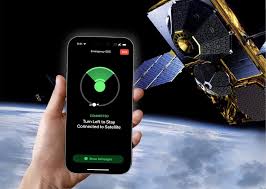
Satellites and Mobile Phone technology
 image ©spacenews
image ©spacenews
The transmission from a mobile to the mast is horizontal to the ground, and the transmission of the data back to the core is (usually) along wires embedded into the ground. But when there are difficulties with either of these options why cannot we use satellites?
The standard satellite phones that expeditions use when really out in remote areas are really bulky, often bulky due to the battery. So one immediate reason why our pones cannot use satellite is the battery requirement. However in recent years we have been putting much lower orbit satellites into space, and to use these with a mobile phone is possible. High end (Apple and Samsung) phones have now built into the comms chips the potential to communicate to a satellite. In the case of Apple, an emergency message (SMS) will be sent to a satellite if there is no ground coverage. This is currently at Apples expense. They have also allowed customers to message (SMS) their contacts, if there is no coverage, again at Apples expense.
Using satellites to send an SMS message will not use much data (160bytes) and the lag is not significant. It would be a different issue if a mobile phone could talk over the satellite, or send data. The cost of allowing all customers to use satellite comms, even only when normal coverage is none existent, would be expensive and the cost would need to be passed onto the customer in some way. In a recent survey the majority of customers stated they would not pay a premium for satellite communications.
In very remote places, where ground wires to a mast is either not practical nor financially viable engineers have to consider other alternatives. The first choice would be mast to mast mobile backhaul. But if this is not possible then satellite is a possibility. People in remote areas use satellite to get the Internet, so \using a satellite as a final option for back haul from a mast is a real possibility. However this will be slower than grond wires and more expensive.
© mobilephonetechnology.co.uk all rights reserved 2017-2025
